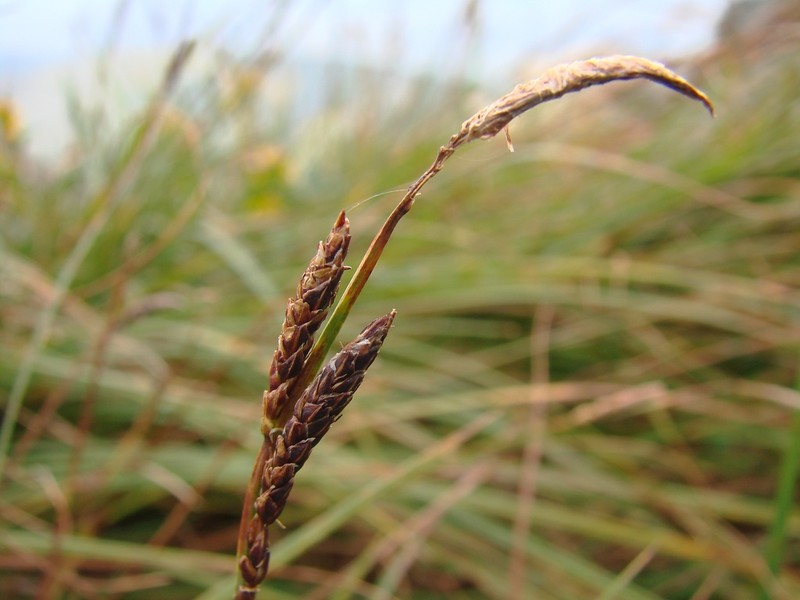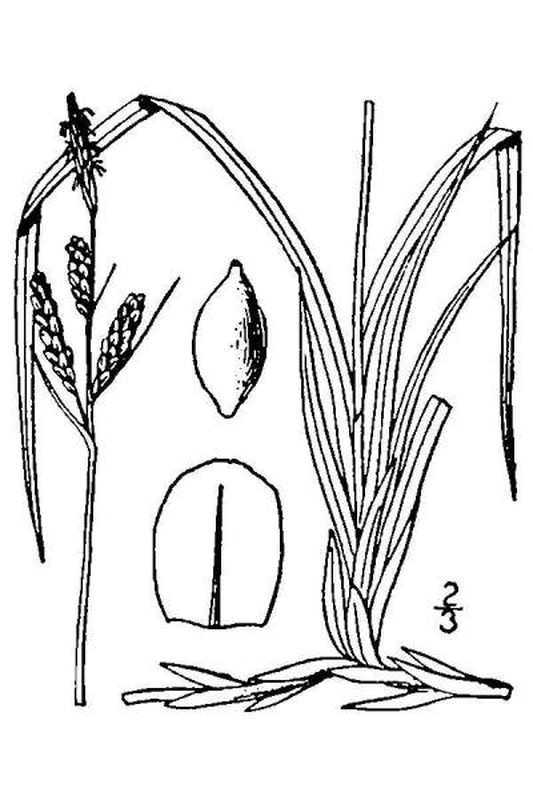Bigelow's Sedge
Carex bigelowii Torr. ex Schwein.
- Class
- Monocotyledoneae (Monocots)
- Family
- Cyperaceae (Sedge Family)
- State Protection
- Threatened
Listed as Threatened by New York State: likely to become Endangered in the foreseeable future. For animals, taking, importation, transportation, or possession is prohibited, except under license or permit. For plants, removal or damage without the consent of the landowner is prohibited.
- Federal Protection
- Not Listed
- State Conservation Status Rank
- S2
Imperiled in New York - Very vulnerable to disappearing from New York due to rarity or other factors; typically 6 to 20 populations or locations in New York, very few individuals, very restricted range, few remaining acres (or miles of stream), and/or steep declines.
- Global Conservation Status Rank
- G5
Secure globally - Common in the world; widespread and abundant (but may be rare in some parts of its range).
Summary
Did you know?
The specific epithet bigelowii is named in honor of its discoverer Jacob Bigelow who lived from 1787 till 1879 (Fernald 1970).
State Ranking Justification
There are currently eleven known populations, all restricted to the Adirondack High Peaks. While these plants may be impacted to some extent by hikers and other recreational activities, their long-term protection is very promising.
Short-term Trends
There is no data documenting short term trends with C. bigelowii. It has been observed that trampling by hikers appears to be negatively impacting populations. Recent efforts by summit stewards to facilitate protection of alpine plants may be helping to reverse this trend. Therefore, although short term trends are not clear they may indicate at least a slight decline.
Long-term Trends
Populations of Carex bigelowii have been known from the high peaks region of the Adirondacks since at least the early 1800's. All but one of these populations is still known. Exact trends are unknown but many populations appear to be healthy and robust. The one population that is only known from historical records has been searched for without success but, the habitat at this site is fairly inaccessible and the population may still be extant. In recent years, some of the populations have been negatively impacted by trampling. Overall, long term trends appear to indicate that this species is stable or declining slightly in New York.
Conservation and Management
Threats
Trampling by hikers is a threat to populations of Carex bigelowii as well as other plants and alpine meadow communities that occur in these areas. At one of the populations this threat appears to be severe. Long term, these populations may be negatively impacted by global climate change.
Conservation Strategies and Management Practices
The summit steward program that works to protect the fragile alpine areas appears to be helpful and should be continued.
Research Needs
Inventories should attempt to get precise information on aerial extent of populations to assess how they might be changing over time.
Habitat
Habitat
Carex bigelowii is confined to alpine areas in New York. It occurs in alpine meadows on thin soil over rock and adjacent to rock outcrops (New York Natural Heritage Program 2006). Dry to moist alpine or arctic tundra (Standley et al. 2002). Alpine meadows (Haines and Vining 1998). Rocky ledges and mountain meadows (Gleason and Cronquist 1991).
Associated Ecological Communities
- Alpine krummholz
(guide)
A dwarf woodland dominated by balsam fir that occurs at or near the summits of the high peaks of the Adirondacks.
- Open alpine community
(guide)
An open community consisting of a mosaic of sedge/dwarf shrub meadows, dwarf heath shrublands, small boggy depressions, and exposed bedrock covered with lichens and mosses. The open alpine community occurs above timberline (about 4,900 ft or 1,620 m) on the higher mountain summits and exposed ledges of the Adirondacks. The flora includes arctic-alpine species that are restricted (in New York) to these areas, as well as boreal species that occur in forests and bogs at lower elevations. The soils are thin and organic, primarily composed of peat derived from peat mosses (Sphagnum spp.) or black muck. The soils are often saturated because they can be recharged by atmospheric moisture.
Associated Species
- Hierochloa alpina ssp. orthanthum
- Juncus trifidus
- Minuartia groenlandica
- Salix uva-ursi (bearberry willow)
- Sibbaldiopsis tridentata
- Trichophorum caespitosum
- Vaccinium uliginosum (bog bilberry)
Range
New York State Distribution
Carex bigelowii ssp. bigelowii is only known from the Adirondack high peaks in Essex County. It is at the southern edge of its range in New York and confined to alpine habitats. Stanley Smith, in the records he kept at the New York State Museum, reports that plants of C. bigelowii (as C. saxatilis) from Mt. Marcy were transplanted to Oriskany Swamp in Oneida Co. This report is a little confusing because C. saxatilis is not a synonym of C. bigelowii. It is unknown if this population is still extant but in either case this population is not tracked by the New York Natural Heritage Program because it is not a native population
Global Distribution
Carex bigelowii occurs in North America, Europe, and Asia. Subspecies bigelowii occurs in North America and Europe. In North America, C. bigelowii spp. bigelowii is known from the Northwest Territories east to Greenland south to New Hampshire, Vermont, New York, Ontario, and Saskatchewan. It is disjunct and isolated on mountains in New England and New York (Standley et al. 2002).
Identification Comments
General Description
Bigelow's sedge is a grass-like perennial. It has long rhizomes and grows in patches in alpine meadows. The leaves are strap-like and 1.5-4.0 mm wide. Stems are 10-50 cm tall and are terminated by 2-5 narrowly cylindrical flower/fruit clusters (spikes). The lower spikes are composed of female flowers which mature into fruits. The upper 1-2 spike(s) are composed of male flowers. The fruits (perigynia) are 1.8-3.5 mm long and are subtended by black scales (Standley et al. 2002).
Identifying Characteristics
Carex bigelowii ssp. bigelowii is long rhizomatous and colonial. Leaf blades are 1.5-4.0 mm wide and leaf sheaths are not ladder-fibrillose. Culms are 10-50 cm tall with the proximal bracts shorter than the inflorescences. The proximal (1-)2-3 spikes are pistillate and the terminal 1(-2) spikes are staminate. Pistillate scales are black and are equal to or shorter than the perigynia they subtend. The perigynia are green with dark spots and 1.8-3.5 mm long (Standley et al. 2002).
Best Life Stage for Proper Identification
Carex bigelowii is easiest to identify when it has immature to mature perigynia. It is a very distinctive species and can be identified at other times of the year as well.
Similar Species
Carex bigelowii is a very distinctive sedge. It is also limited to alpine areas where other closely related species do not grow. It can be distinguished from all other members of section Phacocystis by its lack of ladder-fibrillose basal sheaths, proximal bracts equal to or shorter than the inflorescences, black pistillate scales, and veinless perigynia.
Best Time to See
The phenology of C. bigelowii is effected by altitudes. It starts to flower in June and perigynia begin to form in July and persist into August or sometimes September. By the later part of this season, the perigynia are shedding heavily. Therefore, the best time to survey for C. bigelowii is from July till mid August.
- Fruiting
The time of year you would expect to find Bigelow's Sedge fruiting in New York.
Bigelow's Sedge Images
Taxonomy
Bigelow's Sedge
Carex bigelowii Torr. ex Schwein.
- Kingdom Plantae
- Phylum Anthophyta
- Class Monocotyledoneae
(Monocots)
- Order Cyperales
- Family Cyperaceae (Sedge Family)
- Order Cyperales
- Class Monocotyledoneae
(Monocots)
- Phylum Anthophyta
Additional Common Names
- Sedge
Synonyms
- Carex bigelowii ssp. bigelowii
- Carex concolor R. Br.
- Carex rigida var. bigelowii (Torr. ex Schwein.) Tuck.
Comments on the Classification
Carex bigelowii is a variable taxon with about five subspecies recognized worldwide. New York specimens are all referable to C. bigelowii ssp. bigelowii which is also known from Europe. No other subspecies occur in eastern North America. Plants of C. bigelowii spp. bigelowii in New York and New England tend to be larger and have a more acute perigynia apex than plants from further north. Carex bigelowii is in section Phacocystis. It previously had been placed in section Acutae but this section is no longer considered distinct (Gleason and Cronquist 1991, Standley et al. 2002).
Additional Resources
Best Identification Reference
Gleason, Henry A. and A. Cronquist. 1991. Manual of Vascular Plants of Northeastern United States and Adjacent Canada. The New York Botanical Garden, Bronx, New York. 910 pp.
Other References
Fernald, M.L. 1950. Gray's manual of botany. 8th edition. D. Van Nostrand, New York. 1632 pp.
Haines, A. and T.F. Vining. 1998. Flora of Maine, A Manual for Identification of Native and Naturalized Vascular Plants of Maine. V.F.Thomas Co., Bar Harbor, Maine.
Holmgren, Noel. 1998. The Illustrated Companion to Gleason and Cronquist's Manual. Illustrations of the Vascular Plants of Northeastern United States and Adjacent Canada. The New York Botanical Garden, Bronx, New York.
New York Natural Heritage Program. 2010. Biotics database. New York Natural Heritage Program. New York State Department of Environmental Conservation. Albany, NY.
New York Natural Heritage Program. 2024. New York Natural Heritage Program Databases. Albany, NY.
Reschke, Carol. 1990. Ecological communities of New York State. New York Natural Heritage Program, New York State Department of Environmental Conservation. Latham, NY. 96 pp. plus xi.
Standley, L.A., J. Cayouette, and L. Bruederle. 2002. Carex Linnaeus sect. Phacocystis Dumortier. Pages 379-401 in Flora of North America Editorial Committee (editors), Flora of North America, North of Mexico, Volume 23, Magnoliophyta: Commelinidae (in part): Cyperaceae. Oxford University Press, New York, NY, USA. 608pp + xxiv.
Weldy, T. and D. Werier. 2010. New York flora atlas. [S.M. Landry, K.N. Campbell, and L.D. Mabe (original application development), Florida Center for Community Design and Research http://www.fccdr.usf.edu/. University of South Florida http://www.usf.edu/]. New York Flora Association http://newyork.plantatlas.usf.edu/, Albany, New York
Links
About This Guide
Information for this guide was last updated on: November 4, 2022
Please cite this page as:
New York Natural Heritage Program. 2024.
Online Conservation Guide for
Carex bigelowii.
Available from: https://guides.nynhp.org/bigelows-sedge/.
Accessed July 26, 2024.

